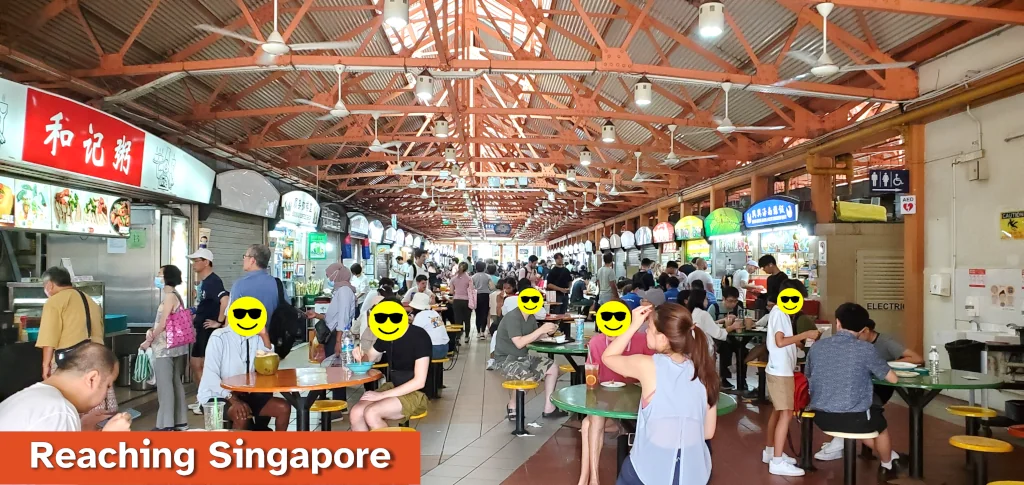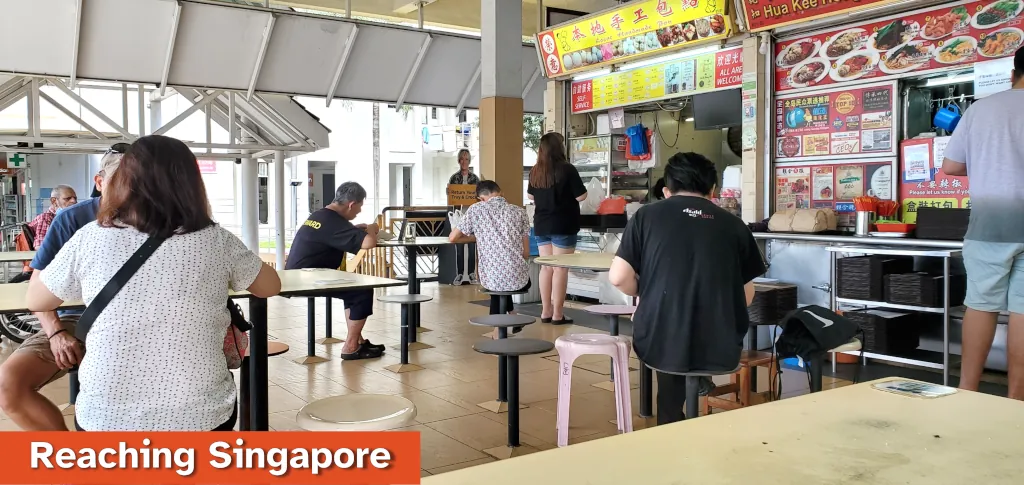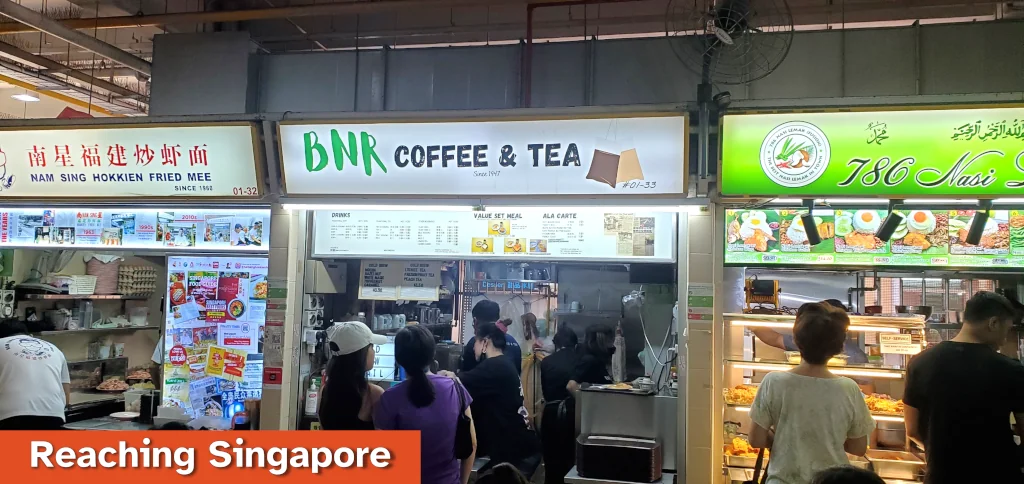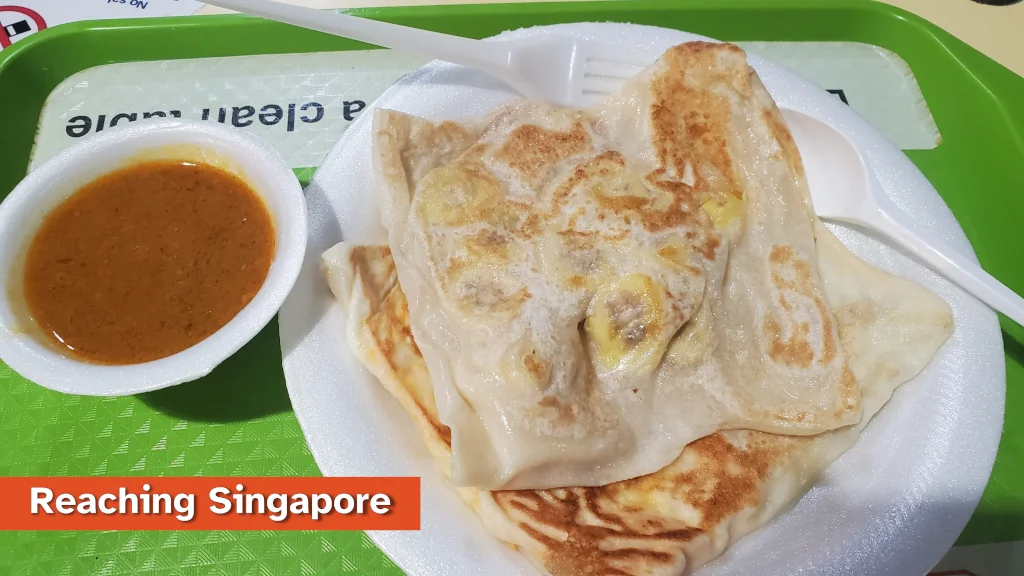How to eat at a hawker centre (step-by-step guide)
I used to find it intimidating to eat at a hawker centre in Singapore. Everyone tells you it’s a ‘must try’ experience, but it can feel overwhelming with all the noise, signs, language barriers and confusion.
So to help visitors to Singapore overcome these feelings, I put together this detailed guide on how to prepare for a hawker centre visit (making sure it’s open for you to visit), how to find a table, how to order food, and rules you have to follow for cleaning up your table afterwards. Hopefully with this guide you won’t feel as confused as I first did.

Also remember to bring a packet of tissues with you when you visit.
1. Research to ensure the stalls are open
Imagine you turn up at the hawker centre, hungry and ready to get something to eat, only to find out it is closed. This has happened to me on multiple occasions: The stall I want to visit is closed or the entire hawker centre is closed.
Hawker stalls close usually at least once a week to give the hawker running it a chance to take a relax. It is difficult to know if the hawker you want to visit will be closed, but chances are the day will be a Sunday, Monday, or Tuesday - depending on the type of food and location of the stall, these are the least busy times for a hawker.
Hawker stalls also close when they run out of food for the day. If you know you’re going to visit a popular lunch or dinner hawker, make sure you arrive early (see below for further info on how to research individual hawker stalls) to make sure you get the dish that the hawker is famous for.
Entire hawker centres usually close a few times a year for cleaning and renovation work. I’ve found these hard to predict, but the NEA publishes a list of planned closures on their website here. If you have a tight schedule, I recommend checking out the list of closures to make sure you’re not planning to visit a closed hawker centre. Publications for closed dates are at least 2 months in advance.
Hawker centres owned by a company (such as Lau Pa Sat and the famous satay street) are not subject to closure - barring a few rare occasions, Lau Pa Sat is open all the time.
To find the best stores to try, usually I search Google for the best stalls to eat at a particular hawker centre. Some of the hawker centres I consistently have good luck finding tasty stalls in include:
- Golden Mile (the food centre on Beach Rd)
- Old Airport Road
- East Coast Lagoon (my favourite place to bring people for satay)
- Maxwell (home of Tian Tian chicken rice)
Lau Pa Sat also has plenty of tasty options, but I find the queues sometimes can be a bit long. My hint if you are going to try the Satay Street though is to avoid the seafood skewers and set menus from the stalls outside. If you’re ordering satay, stick to the meat skewers only, I find the seafood skewers overpriced.
Opening hours for hawker centres are generally 8am to 9pm. Some stalls will open slightly earlier (generally coffee) and some will stay open slightly later (generally beer).
| Hawker Centre | Opening Hours |
|---|---|
| Golden Mile (Beach Rd) | 9:30am to 8pm |
| Old Airport Road | 6am to 10:30pm |
| East Coast Lagoon | 4pm to 10:30pm (opens for lunch on weekends) |
| Maxwell | 8am to 10pm |
Stalls can set their own opening hours, and which days they take as holiday. Some stalls close early when they run out of food (e.g. Tian Tian might say it’s open until 9pm each day, but they often sell out by 8pm). Many stalls will close after 9pm even if the hawker centre stays open longer.
Lau Pa Sat is technically 24 hours, though most stalls visitors want will open from dinner time until 3am (the breakfast at Lau Pa Sat isn’t as good as the lunch or dinner). It is run by a private operator (as opposed to hawker centres which are technically operated by government entities), and sets its own hours. Satay street operates from 7pm until after midnight.
2. Reserve a table using a packet of tissues or umbrella
The first thing I like to do when arriving at a hawker centre is to find a table.
To reserve a table at a hawker centre, leave an item on the table to indicate that you will be coming back. Popular items to leave include a packet of tissues or an umbrella. This process is called “chope” (i.e. to “chope the table”).
Some strategies I like to employ to help reserve a table are:
- Find less popular areas such as outside, or near a closed set of stalls
- Look for people who are finishing up their meal soon and ‘chope’ the table as they are clearing up
- Split up amongst your group - send people in different directions to look for a table, ‘chope’ it, then go and find the rest of the group (remember to remove the ‘chope’ item)
If you’re reserving two adjacent tables, ensure you put something on each table.

I like using a packet of tissues to do this as you can then use the tissues to wipe and clean the table before you eat on it. While hawker centres in Singapore have cleaners to wipe tables, they won’t always have a chance to do so during peak hours and it’s easier to do it yourself.
Do look out for items left at a table before you reserve it, someone else might have reserved it first. Often hawkers like to use the tables outside their stalls as part of the meal serving process or to store food. To be respectful I recommend sitting elsewhere.
3. Find a stall
Once you’ve reserved a table, next step is to go and find something to eat.
If you followed my research advice from earlier then you likely already know the unit number of the stall you want to eat from. Unit numbering does not always make sense, but each hawker centre does have a pattern to the row numbering that you can use to figure out where your stall is located. Sometimes they can be hidden away, so do not be discouraged!
If you’re at a hawker centre and not sure what to eat, here are some of the ways I search for a stall:
- Browse for a dish I feel like eating
- Google the hawker centre to find one of the million blog posts telling you what is good at that hawker centre
- Find a stall with a long queue (popularity means it’s good!)
Stalls typically sell a range of dishes based on their concept, though many famous stores only have 1 dish that they are famous for. Look at what other people are getting from that store and judge for yourself if it’s the sort of thing you’d like to eat.
Some of my favourite foods to order, and their typical prices, are outlined in the table below:
| Dish | Typical Cost |
|---|---|
| Laksa | S$4 - S$9 |
| Chicken Rice | S$4 - S$8 |
| Nasi Lemak | S$4 - S$9 |
| Satay | 70 cents per stick, or S$7 to S$21 per plate |
| Dumplings | S$5 - S$7 per plate |
| Hokkien mee | S$4 - S$7 |
| Char Kway Teow | S$4 - S$7 |

4. Buy food
After figuring out what you want to eat and which stall to get it from, the next step is to actually buy the food. Step-by-step this is:
- Queue at the stall until it is your turn to order
- Make payment
- Wait for the food to cook (some stalls will give you a buzzer, others will expect you to wait for your food)
- Get food, cutlery, and sauces then walk back to your table
Most visitors have to make payment using cash. While QR code cashless payments are available, these aren’t really accessible to tourists or visitors. I wrote a whole guide on how to pay at a hawker centre, check it out here if you’d like more detail: reachingsingapore.com/hawker-payment-methods
Many hawker stalls will have a “Self Service” sign. This means you’re expected to prepare your tray, your sauce, and your cutlery. These will be sitting at the front of the stall waiting for you to prepare them.
Using English to order has never caused me a problem. Unlike ordering from locals in neighbouring countries, every hawker I’ve spoken to is happy to accommodate me when I speak English. Not all hawkers speak English themselves though, so be clear, and be helpful by pointing at the option you want.
5. Buy a drink
Having a drink with your meal is integral to the experience of eating out at a hawker centre in Singapore. I also find it necessary as hawker centres are not air conditioned (they do have fans though).
At many hawker centres, you’ll be approached by a drink seller asking what you would like to drink. The seller will take your order and return with your drinks for payment. Alternatively you can go and find a drink stall in a similar fashion to the food stall.
Some of my personal favourite drinks include:
- Sugar cane juice
- Bandung
- Lime juice (sour drinks make you feel cooler)
- Kopi (ordered as ice kopi C kosong, meaning coffee with evaporated milk and no sugar)
- Beer
Canned soft drinks and bottled water are also available to buy.
Drinks typically cost $1 to $3 depending on the hawker centre. Popular centres tend to charge more for drinks. Freshly made drinks (such as sugar cane and lime juice) cost more, as do alcoholic drinks.
6. Eat
This is the best step in the list - you finally get a chance to eat and enjoy your food.
Make sure you grabbed any sauces that the hawker stall provided. If the sauces are there, the hawker intended you to use these with the dish to maximise the flavour.
7. Clear trays and cutlery
Singapore has a rule requiring that diners at a hawker centre return their trays and cutlery to the return station, and to dispose of any rubbish left on the table.
There are tray return spots dotted around all hawker centres where you can return you tray and cutlery, and dispose of any rubbish.
Usually these are separated into halal and non-halal tray returns. Usually plates and trays from halal stores are coloured green - sometimes Chinese and western food stalls can be halal and served on a green plate.

Further reading
- NEA website listing the schedule of when hawker centres are closed for cleaning and renovation can be found here
- Official government announcement on what the tray return rules are: Here.
- My guide on how to pay at a hawker centre can be found here
- Having trouble getting around Singapore? Check out my guide to Singapore’s MRT here: reachingsingapore.com/singapore-catch-train-guide

